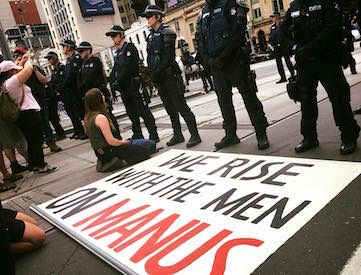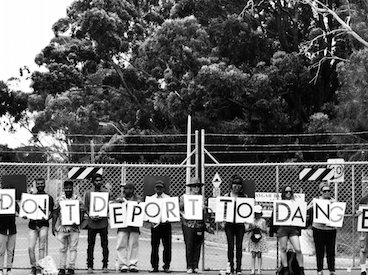Workers must stand with fellow workers and unionists and not acquiesce to police demands to break up democratic protests, writes human rights activist, Gaye Demanuele.
IT HAS BEEN a busy few weeks for people willing and able to take the fight to the streets in Narrm (Melbourne) for human rights and environmental defence.
The Australian Government brought a humanitarian crisis to a new peak in its cruel treatment of refugees and asylum seekers held as political prisoners on Manus Island.
Immigration and Border Protection Minister Dutton’s starvation and dehydration tactics, with denial of medical aid, did not alter the courageous resistance stance of the prisoners who refused to be moved to another prison camp on Manus Island.
Under Australian Border Force and Australian Federal Police watch, they were beaten by the notorious PNG Mobile Squad to make them leave the compound. These events created a real sense of emergency among Australian people, with a resurgence of attendance at rallies and indirect actions to disrupt business as usual. The demands are clear: to evacuate Manus Island and Nauru detention facilities and to resettle the asylum seekers and refugees safely.

PNG police armed with long metal poles force men out of the Manus Island detention centre yesterday. (Photo courtesy Canberra Refugee Action Committee.)
In step with the increased mobilisation on the streets came an increased police presence with the use of intimidation tactics. Militarised “robocops” lined the streets, with mounted police on alert in laneways, in an attempt to stop the people marching and blocking roadways. This has created a contested space, with the State seeking to block intersection occupations that disrupt business as usual. Paradoxically, this has resulted in the police blocking the intersections in place of the protesters.
Friday night, one week ago (24 November), became a critical point in the state’s objective to control activist freedom of movement and right to demonstrate. Several known fascists made an incursion into the protest space. The police intervened, not to defend those representing human rights, but to arrest an activist who had been attacked by a fascist. While some cops had a familiar little chat with the fascists down on the corner, other cops beat an activist until he was bloodied and limp.
It was obvious that an ambulance was needed; an ambulance was called, but police prevented it reaching the man who was held in the “brawler” for approx 40 minutes until he was driven to the police station — not the hospital. Fortunately, he was not as badly injured as first suspected.

(Photo courtesy of Red Flag)
The issue of why the paramedics were not permitted to treat a patient, remains. Did the paramedics, as health professionals, question the police decision to delay medical treatment? Prisoners have died in the back of police vans.
Close the Camps Action Collective asks United Voice and the Health Services Union what their position is on the delay of medical treatment by their members to a fellow worker and unionist at the direction of the police.
After the police “intervention”, the air was peppered with OC spray. The mood of the crowd was electrified with worry for their fellow protesters. The people were determined not to be kettled on the streets. They pushed through police lines chanting “We will march!” to occupy the contested space of the Flinders Street intersection, shutting it down for several hours by encircling the police lines.
On the following Sunday (26 November), a protest against state violence on Manus, Nauru and on the streets of Melbourne marched to the #SOSManus GetUp rally from Bourke Street Mall. Again, there was a show of miltarised force, but the police could not stop the power of the people. Once again, the intersection was blocked. The mood of the crowd was calm and powerful. People shared water, food, umbrellas and sunscreen. Passers-by shared their support and many challenged the police present as to why they appeared equipped for a war zone, rather than a peaceful protest on the streets of an Australian city.
Stymied by the activists sitting peacefully on the road, the police directed a tram driver to nudge his tram up to the police line to effectively divide the protesters. They may have been physically divided, however, they remained united in purpose and communication.
Close the Camps Action Collective asks the Rail, Bus and Tram Union (RBTU) what its position is on the use of members by the police to attempt to break up protests.
Their fellow workers and unionists were protesting human rights crimes committed by the Federal Government, not sitting on the road for no particular reason. This is the very same Government that slashed penalty rates and instigated attacks on unions, including the tactic of police raids on their offices.
Last Wednesday (29 November), climate justice activists and environmental defenders protested at Parliament House, Spring Street Melbourne against the State Government’s logging of old growth forests, and the critical endangerment of native species. An experienced climber suspended himself from the roof in an attempt to unfurl a banner. The police refused to negotiate with the police liaison team. Instead, they unnecessarily called in the Metropolitan Fire Brigade rescue team and truck. Two firefighters, at the direction of the police, used the sky lift on the truck to facilitate the removal of the climber – a fellow worker – from the roof anchor points.
Close the Camps Action Collective asks the United Firefighters Union what their position is on the use of their members by the police to attempt to break up protests.
Meanwhile, another activist was falsely imprisoned by construction workers on the adjacent building site until the police arrived. A worker wearing a shirt with Construction, Forestry, Mining and Energy Union (CFMEU) insignia walked past the activists yelling at them, unoriginally, to “get a job”. They do have jobs — mostly jobs in an insecure casualised workforce.
Close the Camps Action Collective asks the CFMEU what their position is on the use of their members by the police to attempt to break up protests. We remind the CFMEU that there are no jobs on a dead planet and invite members to fight together for environmentally sustainable jobs.
Last Friday night, the police leapfrogged the metaphorical line in the sand they had drawn in Swanston Street. A peaceful combined demonstration by the Free West Papua community and grassroots refugee rights activists went ahead despite the dire weather predictions. The action was supported by the National Union of Workers (NUW) members and the platform included a NUW organiser, who is a former refugee.
As the weather held off, the decision was made to go ahead with the planned march, however with a change of route that accommodated the necessity for the West Papuans to deliver their freedom canoe to the ACU gallery in Fitzroy before the predicted storms hit.

Free West Papua freedom canoe in Melbourne (Photo by Charandev Singh: supplied)
The procession, led by singers and dancers towing the Freedom canoe with children atop, bypassed the line of police that blocked Swanston Street and, instead, marched towards the Victorian Trades Hall in nearby Carlton. The marchers temporarily occupied the intersection in front of Trades Hall for more speeches and songs while the children played. The police surrounded the crowd while the Public Order Response Team (PORT), in full militarised gear, blocked all the doors of the Trades Hall.
What disruption of public order required the PORT to blockade Trades Hall? Who was this show of force intended to intimidate? What message was the state broadcasting in the display of robocops up at union headquarters?
Many activists, whether they fight for human rights or as environmental defenders, or both, also support workers’ rights and unions. They have supported campaigns, signed petitions, marched and boycotted. They have and will join the community picket in support of the Maritime Union of Australia (MUA) workers' dispute, currently in place down on the Webb dock. They are fellow workers and unionists.
Close the Camps Action Collective asks the Victorian Trades Hall Council to review its affiliation with Police Association Victoria. The police, as enforcers of the State, break up pickets and break up protests. They bash our fellow protesters and they assist deportations of asylum seekers who have not had the opportunity to exercise their full rights to seek asylum.
The police must be held to account: stand down from breaking up workers’ pickets, and breaking up protests for human rights and environmental defenders, or be disaffiliated from the Victorian Trades Hall Council (VTHC) — the union council of workers.
Gaye Demanuele is a member of the Close the Camps Action Collective. You can follow Gaye on Twitter @gayedemanuele and the Close the Camps Action Collective @CloseTheCamps.

This work is licensed under a Creative Commons Attribution-NonCommercial-NoDerivs 3.0 Australia License
Monthly Donation
Single Donation
Support democracy. Subscribe to IA.











